Ageing and sexing details:
|
JAN - JUL: after-second-year
male |
ASY males have extensive black on the chin and throat and on average have more waxy tips than any other age/sex.
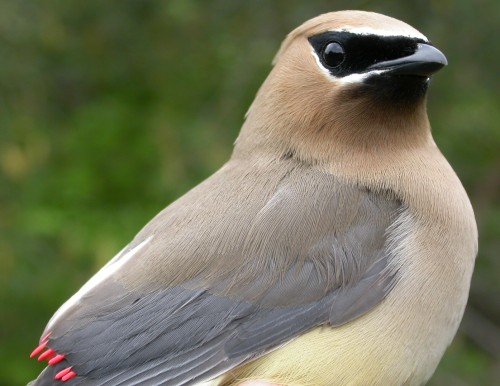
An ASY male with a solid dark chin extending into the throat.
Photo by Marcel Gahbauer,
McGill Bird Observatory (QC), May 2005
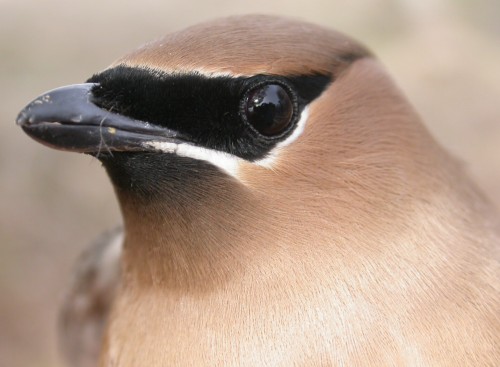
A closeup of the face, again showing a very dark chin and throat.
Photo by Marcel Gahbauer,
McGill Bird Observatory (QC), April 2006
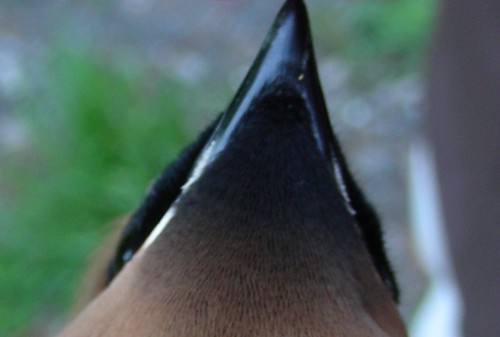
A view from underneath, highlighting the dark throat of an ASY male.
Photo by Marie-Anne Hudson,
McGill Bird Observatory (QC),May 2008
ASY Cedar Waxwings have a uniformly grayish wing, and average a higher count of waxy tips than other age/sex combinations. Individuals with 8 or 9 waxy tips are almost always ASY males.
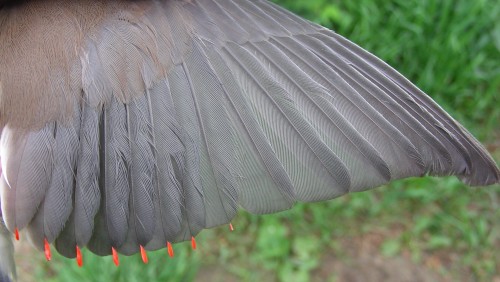
An ASY male wing, with an above average count of 8 waxy tips.
Photo by Marie-Anne Hudson,
McGill BIrd Observatory (QC), May 2007
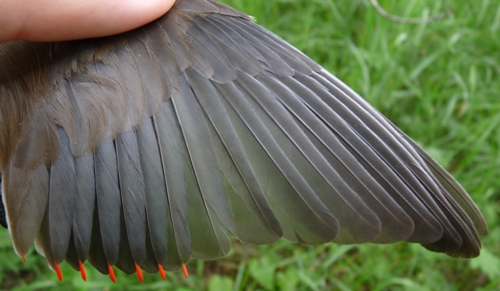
An ASY male with 7 waxy tips, and again a generally uniform wing.
Photo by Marcel Gahbauer,
Inglewood Bird Sanctuary (AB), July 2009
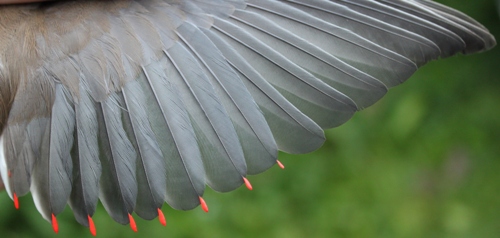
Another ASY male with 8 waxy tips.
Photo by Peter Pyle, Braddock Bay Bird Observatory (NY), May 2010
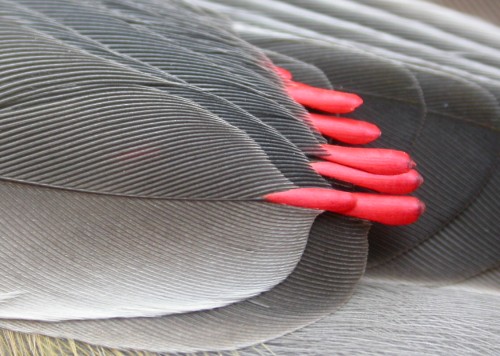
A closeup of the waxy tips on an ASY male.
Photo by Marcel Gahbauer,
McGill Bird Observatory (QC), April 2006
Although there is considerable overlap, ASY males on average have the longest yellow tips on their rectrices. Although ASY rectrices are on average slightly more rounded at the tip, the difference is generally too slight to be of use for ageing.
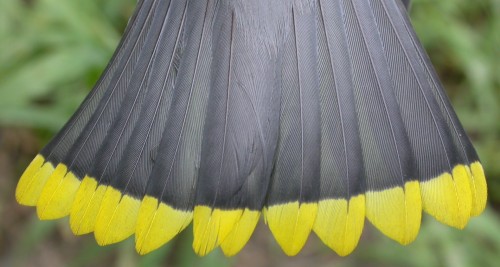
A typical ASY male tail.
Photo by Marcel Gahbauer,
McGill Bird Observatory (QC), May 2006
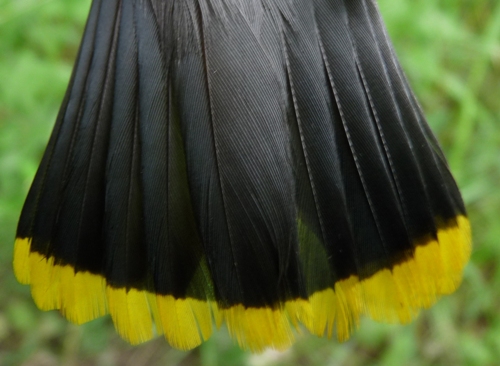
Another typical ASY male tail, showing a bit of wear just prior to the prebasic molt.
Photo by Marcel Gahbauer,
Calgary Bird Banding Society (AB), July 2009
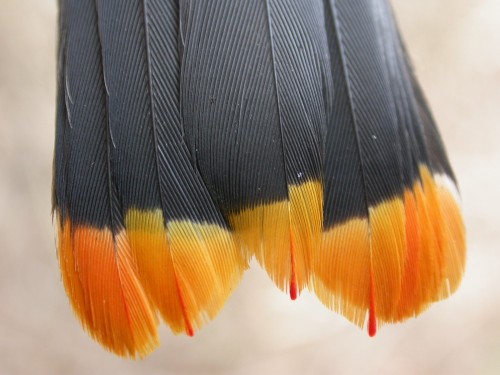
An unusually orange tail, with small waxy tips also developing on some rectrices.
Photo by Marcel Gahbauer,
McGill Bird Observatory (QC), April 2006
RETURN TO AGE/SEX
OVERVIEW
|
JAN - JUL: after-second-year
female |
ASY females are similar to ASY males but have a smaller amount of black on the chin and on average have slightly fewer waxy tips on the wing.

A typical ASY female.
Photo by Marie-Anne Hudson,
McGill Bird Observatory (QC), May 2007
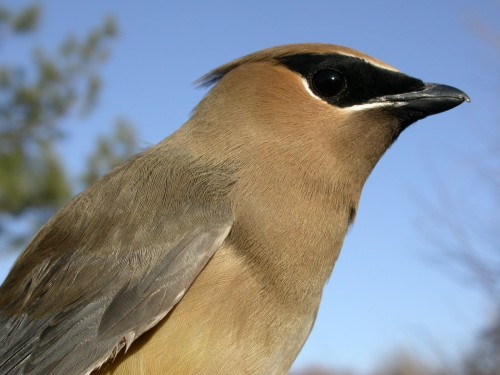
Another ASY female, showing the somewhat more limited black on the chin in
comparison to males.
Photo by Marcel Gahbauer,
McGill Bird Observatory (QC), May 2005
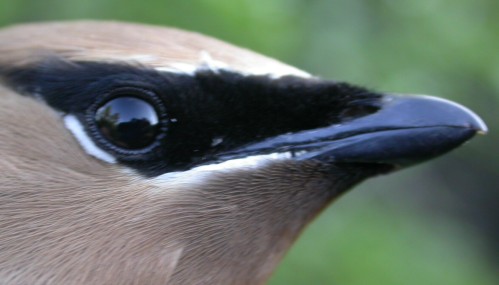
A closeup showing the black of the chin largely restricted to near the base
of the lower mandible.
Photo by Marcel Gahbauer, McGill Bird Observatory (QC), May 2006
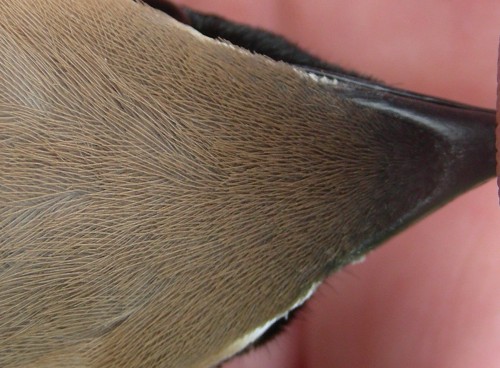
A view from below highlighting the limited black on the chin of an ASY female.
Photo by Marie-Anne Hudson, McGill Bird Observatory (QC), May 2007
ASY females generally have at least some waxy tips on the wing, and usually have no more than 7, although the average count is smaller.
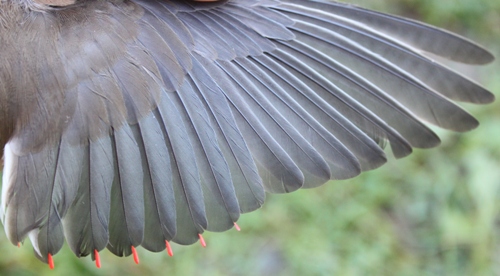
An ASY female wing, essentially identical to the appearance of an ASY male.
Photo by Peter Pyle, Braddock Bay Bird Observatory (NY), May 2010
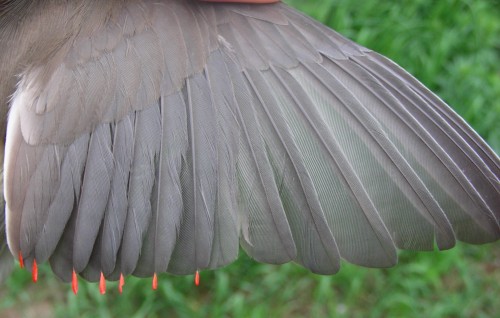
Another typical ASY female wing.
Photo by Marie-Anne Hudson,
McGill Bird Observatory (QC), May 2007
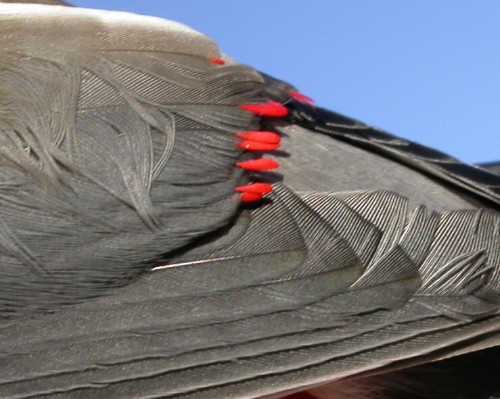
A closeup of the waxy tips on the folded wing of an ASY female.
Photo by Marcel Gahbauer,
McGill Bird Observatory (QC), May 2005
Although there is considerable overlap, ASY females on average have slightly shorter yellow tips on their rectrices than ASY males. Although ASY rectrices are on average slightly more rounded at the tip, the difference is generally too slight to be of use for ageing.
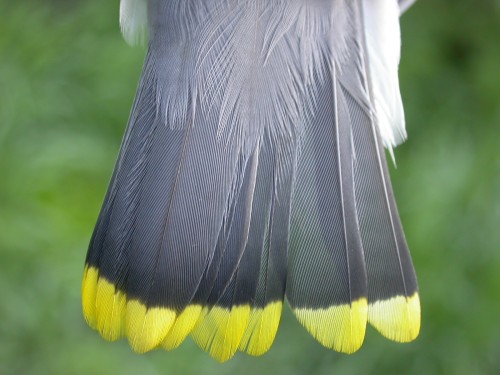
A typical ASY female tail.
Photo by Marcel Gahbauer,
McGill Bird Observatory (QC), May 2006
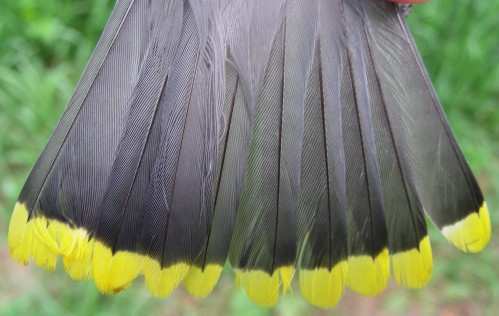
Another ASY female tail.
Photo by Marie-Anne Hudson,
McGill Bird Observatory (QC), May 2007
RETURN TO AGE/SEX
OVERVIEW
|
JAN - JUL: second-year
male |
SY males are similar to older males with respect to the extent of black on the chin and throat, but they usually have few if any waxy tips on the wing, although occasionally as many as 7 may be present.
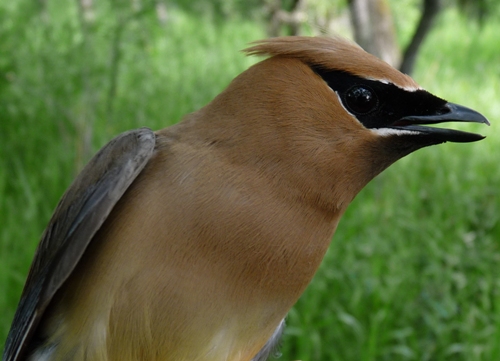
A typical SY male with respect to black on the chin and throat.
Photo by Marcel Gahbauer,
Calgary Bird Banding Society (AB), July 2009
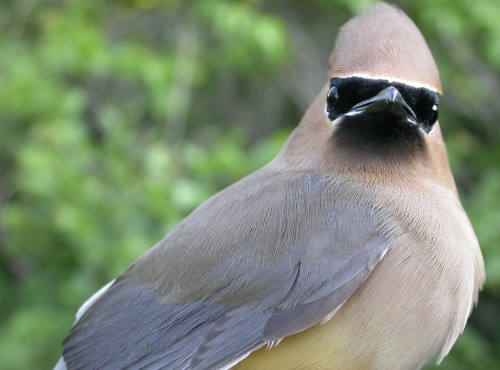
A front view of an SY male, highlighting the extensively black chin and throat.
Photo by Marcel Gahbauer,
May 2006
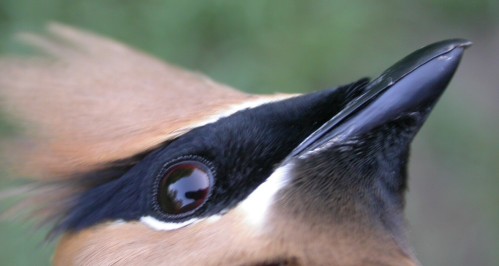
A closeup of the black chin and throat of an SY male.
Photo by Marcel Gahbauer,
May 2006
SY males are most readily distinguished from older males if they entirely lack waxy tips on the wing. However, since ASY males may have as few as three secondaries with waxy tips, and SY males may have as many as 7, there is considerable overlap, and these individuals may be difficult to age unless the tail is particularly distinct.
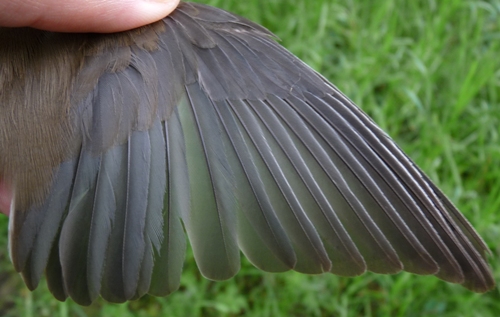
A wing lacking any waxy tips, in combination with a black chin and throat is a good
indicator of an SY male Cedar Waxwing.
Photo by Marcel Gahbauer,
Calgary Bird Banding Society (AB), July 2009
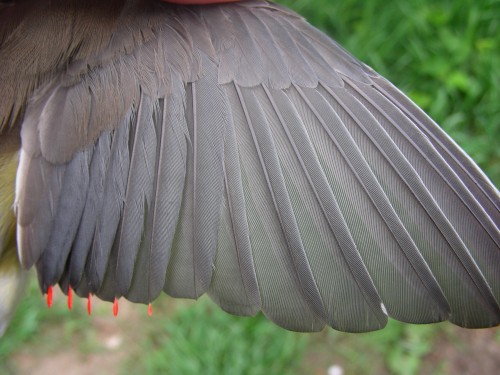
An SY male with an intermediate number of waxy tips; age was determined by tail.
Photo by Marie-Anne Hudson,
McGill Bird Observatory (QC), May 2007
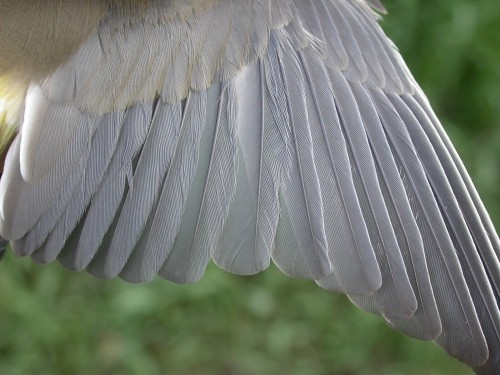
Another SY male lacking any waxy tips.
Photo by Marcel Gahbauer, May 2006
Although there is considerable overlap, SY males on average have slightly shorter yellow tips on their rectrices than ASY males; those with particularly limited yellow (3-5 mm) are very likely SY males. Although SY rectrices are on average slightly more pointed at the tip, the difference is generally too slight to be of use for ageing.
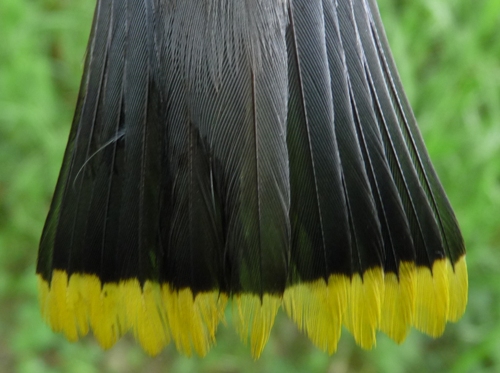
An example showing relatively pointed rectrices.
Photo by Marcel Gahbauer,
Calgary Bird Banding Society (AB), July 2009
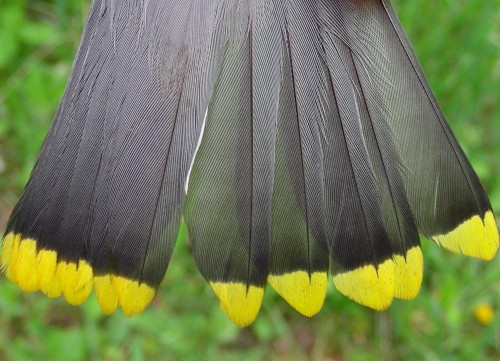
An example of rectrix shape being similar to that of ASY males
Photo by Marie-Anne Hudson, McGill Bird Observatory (QC), May 2008
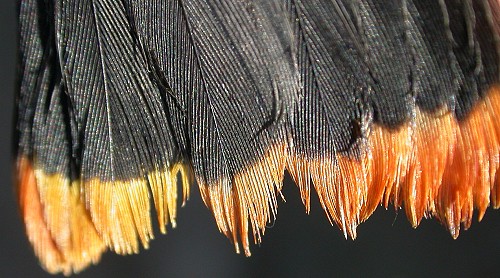
An individual with unusually orange tips to its rectrices.
Photo by Marcel Gahbauer,
McGill Bird Observatory (QC), May 2005
RETURN TO AGE/SEX
OVERVIEW
|
JAN - JUL: second-year
female |
Like ASY females, SY females have a relatively limited amoung of black on the chin and throat. They rarely have any waxy tips on the wings, but may have as many as three.
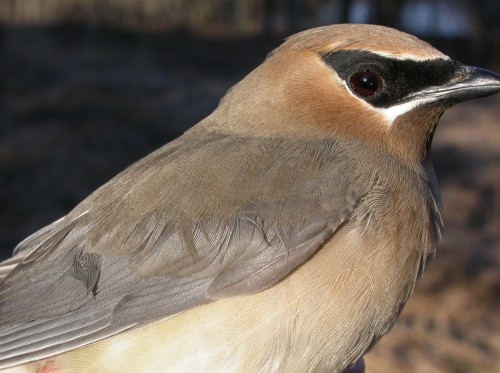
A typical SY female, showing little black on the chin and throat.
Photo by Marcel Gahbauer,
McGill Bird Observatory (QC), May 2005

A closeup, showing the limited amount of black on the chin.
Photo by Marcel Gahbauer,
McGill Bird Observatory (QC), May 2006
SY females rarely have any waxy tips, though some individuals may have as many as three. Note, however, that ASY females may also have as few as one waxy tip, therefore there are some intermediates that cannot be aged reliably by wing.
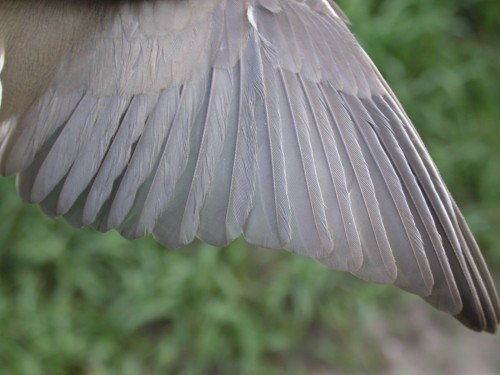
Photo by Marcel Gahbauer,
McGill Bird Observatory (QC), May 2006
SY females usually have a narrower yellow terminal band on the tail than other age/sex combinations, although at the upper end of the range they may overlap with older females. While the rectrices may be somewhat narrower on SY waxwings, it is rare that shape differs enough between ages to be helpful for ageing.
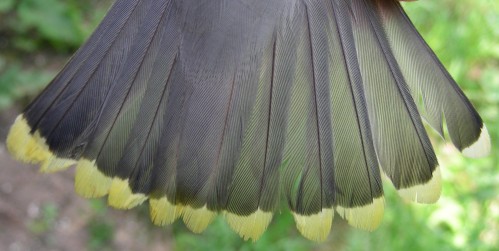
An SY female with a relatively broad terminal band on the tail.
Photo by Marie-Anne Hudson,
McGill Bird Observatory (QC), May 2007
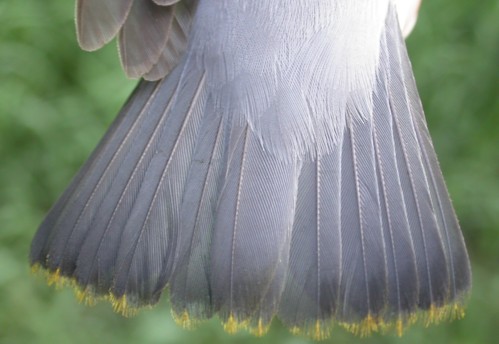
An SY female with a particularly limited amount of yellow on the tail.
Photo by Marcel Gahbauer,
McGill Bird Observatory (QC), May 2006
RETURN TO AGE/SEX
OVERVIEW
|
JUL - DEC: after-hatch-year
male |
AHY males have extensive black on the chin and throat and on average have more waxy tips than any other age/sex.

A typical AHY male, with an extensive black chin and throat, and a large number
of waxy tips visible on the secondaries.
Photo by Marcel Gahbauer, Cypress Hills Provincial Park (AB), August 2010
AHY males on average have the greatest number of waxy tips on the wing; although HY males may have as many as 7 waxy tips, they more commonly have few or none, therefore individuals with a large number are most likely AHY males, although this should usually be affirmed by checking other features.
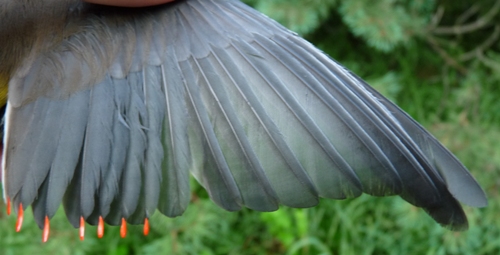
Photo by Marcel Gahbauer, Cypress Hills Provincial Park (AB), August 2010
AHY males on average have the broadest yellow terminal band on the tail.
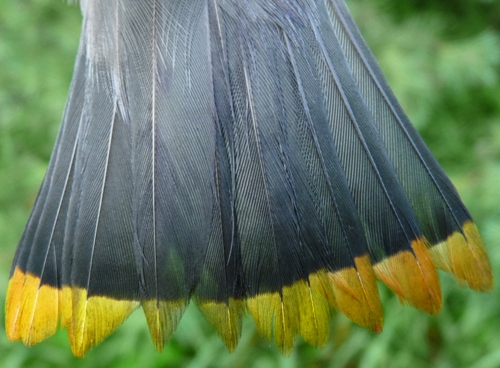
Photo by Marcel Gahbauer, Cypress Hills Provincial Park (AB), August 2010
RETURN TO AGE/SEX
OVERVIEW
|
JUL - DEC: after-hatch-year
female |
AHY females are similar to AHY males but have a smaller amount of black on the chin and on average have slightly fewer waxy tips on the wing.
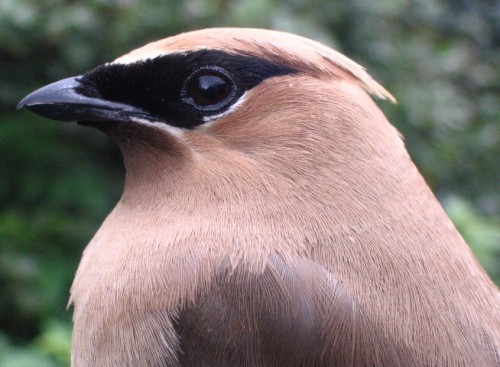
Photo by Seabrooke Leckie,
McGill Bird Observatory (QC), August 2006
AHY females generally have at least some waxy tips on the wing, and usually have no more than 7, although the average count is smaller.
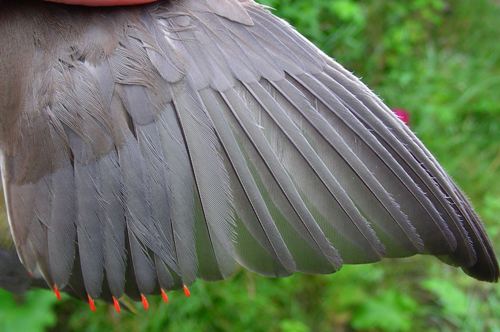
Photo by Marie-Anne Hudson, McGill Bird Observatory (QC), August 2008
Although there is considerable overlap, AHY females on average have slightly shorter yellow tips on their rectrices than AHY males. While AHY rectrices are on average slightly more rounded at the tip, the difference is generally too slight to be of use for ageing.
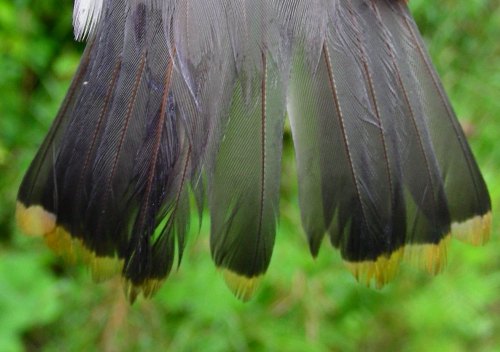
Photo by Marie-Anne Hudson, McGill Bird Observatory (QC), August 2008
RETURN TO AGE/SEX
OVERVIEW
|
JUL - DEC: hatch-year
male / female |
HY Cedar Waxwings are usually readily separable from AHY individuals by retaining some streaking on the breast through the end of the year. Sex is not always distinguishable at this age, but wing and especially tail may be helpful in some cases.
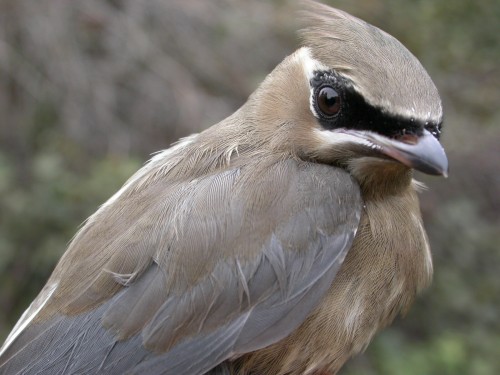
An HY waxwing with a relatively minor amount of streaking on the breast.
Photo by Marcel Gahbauer,
McGill Bird Observatory (QC), September 2005
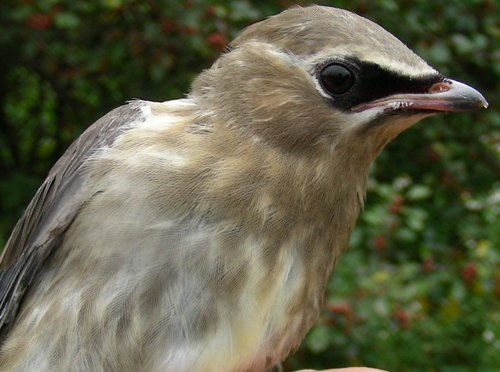
A more heavily streaked HY waxwing.
Photo by Marcel Gahbauer, McGill Bird Observatory (QC), September 2008
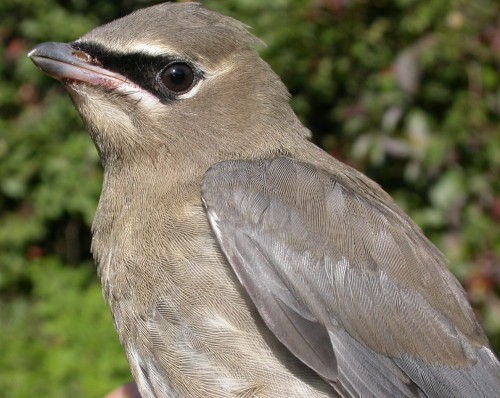
Photo by Marcel Gahbauer,
McGill Bird Observatory (QC), September 2005
HY waxwings often have zero waxy tips, but males may have as many as 7; those with more than 3 are almost certainly males.
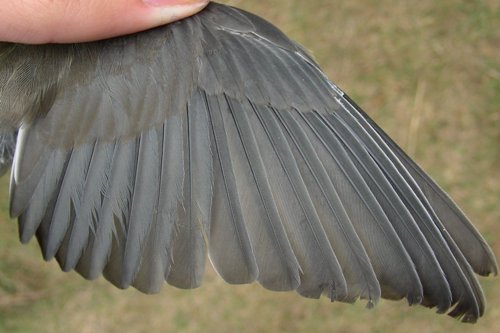
An HY wing lacking any waxy tips, which is common for both sexes.
Photo by Marcel Gahbauer, McGill Bird Observatory (QC), September 2008
HY males are most easily separated from females by the length of the yellow terminal band on the tail. On males it is at least 3 mm long, and on average at least a couple of mm longer than that; on females it is rarely over 4 mm long, and on average a couple of mm shorter.

An HY male, by length of the terminal band on the tail.
Photo by Marcel Gahbauer, McGill Bird Observatory (QC), September 2008
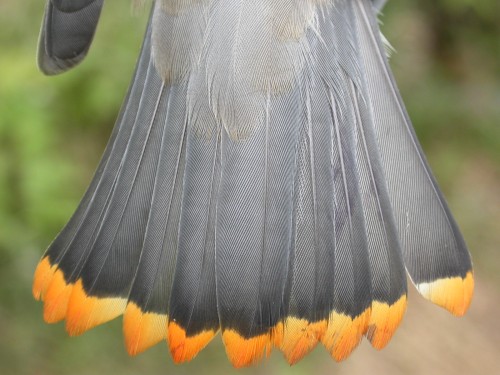
An orange-tipped variant, likely male by the wideth of the terminal band.
Photo by Marcel Gahbauer,
McGill Bird Observatory (QC), September 2005
RETURN TO AGE/SEX
OVERVIEW
|
JUL - OCT: juvenile
male / female |
Juvenile waxwings are largely similar in appearance to HY individuals, although usually lacking or just beginning to develop the black facial mask. Sex is often impossible to determine at this age, although some males already have a large number of waxy tips.
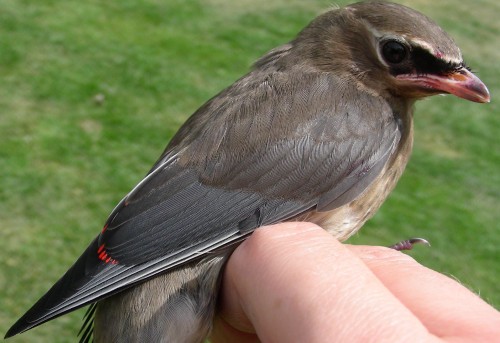
A juvenile male, recognizable as such by the large number of waxy tips already
developing on the secondaries.
Photo by Marie-Anne Hudson, Le Nichoir, August 2007
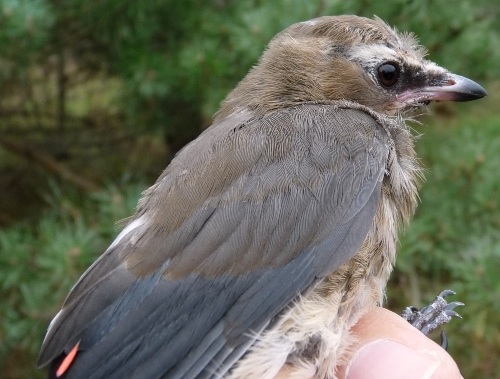
A juvenile surprisingly late in fall, with the black mask just beginning to develop; with
only one waxy tip, sex could not be determined by wing alone, but in combination with
a broad terminal band on the tail, was identified as a male.
Photo by Marcel Gahbauer, McGill Bird Observatory (QC), October 2009
Juvenile wings typically have no waxy tips, although there are rare exceptions.
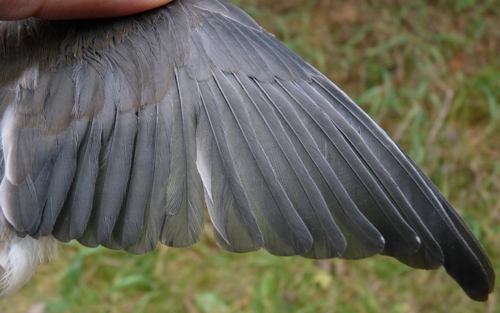
A typical juvenile wing.
Photo by Marcel Gahbauer, McGill Bird Observatory (QC), October 2009

An unusual juvenile male, already with 7 waxy tips developing.
Photo by Marie-Anne
Hudson, Le Nichoir, August 2007
The width of the terminal band on the tail is in most cases the only way that sex of juvenile Cedar Waxwings may be determined. As with HY individuals, the minimum width on males is around 3 mm, while the maximum width on females is just over 4 mm.
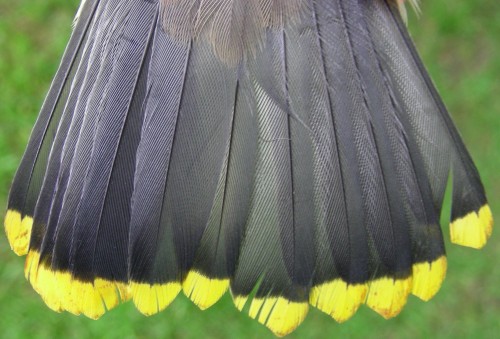
A probable male, based on width of the terminal band.
Photo by Marie-Anne Hudson, Le Nichoir, August 2007
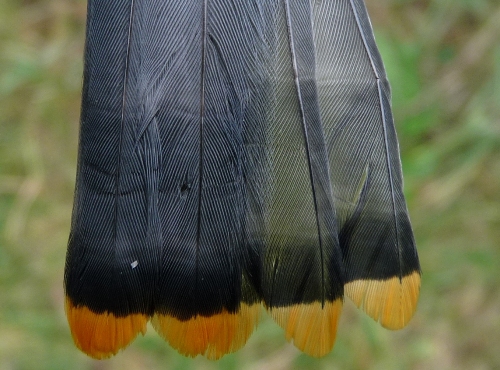
Another probable male based on width of the terminal band; note also the unusual
dark pre-terminal band, and the orange instead of yellow terminal band.
Photo by Marcel Gahbauer, McGill Bird Observatory (QC), October 2009
RETURN TO AGE/SEX
OVERVIEW